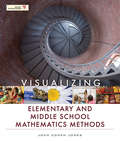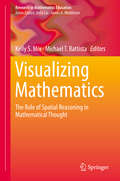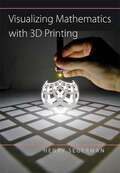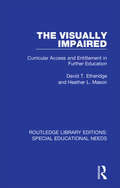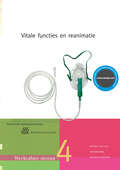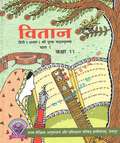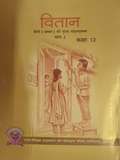- Table View
- List View
Visualization and Optimization (Operations Research/Computer Science Interfaces Series #6)
by Christopher V. JonesThis book arose out of an invited feature article on visualization and opti mization that appeared in the ORSA Journal on Computing in 1994. That article briefly surveyed the current state of the art in visualization as it ap plied to optimization. In writing the feature article, it became clear that there was much more to say. Apparently others agreed, and thus this book was born. The book is targeted primarily towards the optimization community rather than the visualization community. Although both optimization and visualization both seek to help people understand complex problems, prac titioners in one field are generally unaware of work in the other field. Given the common goals of the respective fields, it seemed fruitful to consider how each can contribute to the other. One might argue that this book should not be focused specifically on optimization but on decision making in general. Perhaps, but it seems that there is sufficient material to create a book targeted specifically to optimization. Certainly many of the ideas presented in the book are appli cable to other areas, including computer simulation, decision theory and stochastic modeling. Another book could discuss the use of visualization in these areas.
Visualization in Mathematics, Reading and Science Education: Visualization In Mathematics, Reading And Science Education (Models and Modeling in Science Education #5)
by Linda M. Phillips Stephen P. Norris John S. MacnabScience education at school level worldwide faces three perennial problems that have become more pressing of late. These are to a considerable extent interwoven with concerns about the entire school curriculum and its reception by students. The rst problem is the increasing intellectual isolation of science from the other subjects in the school curriculum. Science is too often still taught didactically as a collection of pre-determined truths about which there can be no dispute. As a con- quence, many students do not feel any “ownership” of these ideas. Most other school subjects do somewhat better in these regards. For example, in language classes, s- dents suggest different interpretations of a text and then debate the relative merits of the cases being put forward. Moreover, ideas that are of use in science are presented to students elsewhere and then re-taught, often using different terminology, in s- ence. For example, algebra is taught in terms of “x, y, z” in mathematics classes, but students are later unable to see the relevance of that to the meaning of the universal gas laws in physics, where “p, v, t” are used. The result is that students are c- fused and too often alienated, leading to their failure to achieve that “extraction of an education from a scheme of instruction” which Jerome Bruner thought so highly desirable.
Visualization in Science Education (Models and Modeling in Science Education #1)
by John K. GilbertThis book addresses key issues concerning visualization in the teaching and learning of science at any level in educational systems. It is the first book specifically on visualization in science education. The book draws on the insights from cognitive psychology, science, and education, by experts from five countries. It unites these with the practice of science education, particularly the ever-increasing use of computer-managed modelling packages.
Visualization: Theory and Practice in Science Education (Models and Modeling in Science Education #3)
by John K. Gilbert Miriam Reiner Mary NakhlehExternal representations (pictures, diagrams, graphs, concrete models) have always been valuable tools for the science teacher. This book brings together the insights of practicing scientists, science education researchers, computer specialists, and cognitive scientists, to produce a coherent overview. It links presentations about cognitive theory, its implications for science curriculum design, and for learning and teaching in classrooms and laboratories.
Visualization Tools for Learning Environment Development (SpringerBriefs in Educational Communications and Technology)
by Joseph Frantiska Jr.This brief discusses and explains how an educator can use various tools (Use Case, IPO diagrams, flowcharts, entity-relationship diagrams, information mapping) to help visualize how a learning environment will work. Such tools were originally developed for use by software engineers but as the complexity of learning environments has increased with various interfaces and processing, both educators and students have developed a need to understand the design and development of visualization tools. The primary audiences for this text are K-12 and post-secondary educators and instructional designers who want to use tools that will allow them to develop effective learning environments in an efficient manner. Undergraduate and graduate students in an educational technology class can also employ these tools and techniques to develop their own materials.
Visualizations and Dashboards for Learning Analytics (Advances in Analytics for Learning and Teaching)
by Dirk Ifenthaler Muhittin SahinThis edited volume fills the gaps in existing literature on visualization and dashboard design for learning analytics. To do so, it presents critical tips to stakeholders and acts as guide to efficient implementation. The book covers the following topics: visualization and dashboard design for learning analytics, visualization and dashboard preferences of stakeholders, learners’ patterns on the dashboard, usability of visualization techniques and the dashboard, dashboard and intervention design, learning and instructional design for learning analytics, privacy and security issues about the dashboard, and future directions of visualization and dashboard design.This book will be of interest to researchers with interest in learning analytics and data analytics, teachers and students in higher education institutions and instructional designers, as it includes contributions from a wide variety of educational and psychological researchers, engineers, instructional designers, learning scientists, and computer scientists interested in learning analytics.
Visualize Your Teaching: Understand Your Style and Increase Your Impact
by Kyle EzellVisualize Your Teaching offers a unique way of helping educators see their own teaching so they can strengthen their practice. Author Kyle Ezell uses a series of simple but compelling black and white graphics to take you through teaching’s parts, flows, and signals. He demonstrates that it’s important to be aware of what’s happening when playing distinctly different parts as you teach, depending on the context. Flows connect parts together over a lesson. He shows how to visualize the impact of how flows connect over a range of circumstances. You also need to be aware of how you respond to many different signals that appear, pushing and pulling the lesson plan. Appropriate for teachers of all grade levels and subject areas, the book provides teaching scenario prompts for you to practice playing all the parts through self-observation and opportunities for you to diagram your own teaching. As you work through the pages, you’ll be able to visualize your performance the way athletes do, becoming more in tune with yourself. With this book as your batting cage, you will be increasing your impact on students in no time!
Visualize Your Teaching: Understand Your Style and Increase Your Impact
by Kyle EzellVisualize Your Teaching offers a unique way of helping educators see their own teaching so they can strengthen their practice. Author Kyle Ezell uses a series of simple but compelling black and white graphics to take you through teaching’s parts, flows, and signals. He demonstrates that it’s important to be aware of what’s happening when playing distinctly different parts as you teach, depending on the context. Flows connect parts together over a lesson. He shows how to visualize the impact of how flows connect over a range of circumstances. You also need to be aware of how you respond to many different signals that appear, pushing and pulling the lesson plan. Appropriate for teachers of all grade levels and subject areas, the book provides teaching scenario prompts for you to practice playing all the parts through self-observation and opportunities for you to diagram your own teaching. As you work through the pages, you’ll be able to visualize your performance the way athletes do, becoming more in tune with yourself. With this book as your batting cage, you will be increasing your impact on students in no time!
Visualizing Argumentation: Software Tools for Collaborative and Educational Sense-Making (Computer Supported Cooperative Work)
by Chad S. Carr Simon J.Buckingham Shum Paul A. KirschnerThis text examines the use of collaboration technologies in the problem-solving or decision-making process. These systems are widely used in both education and in the workplace to enable virtual groups to discuss and exchange ideas on issues ranging from applied problems to theoretical debate. While some systems are text-based, the majority rely on visualization techniques to allow participants to represent their ideas in a more flexible, graphical form. The text evaluates existing systems, and looks at how the specific needs of users in both educational and corporate environments can be reflected in the design of new systems.
Visualizing Dynamic Systems: Volumetric and Holographic Display (Synthesis Lectures on Engineering, Science, and Technology)
by Mojgan M HaghanikarThis book is aimed to help instructional designers, science game designers, science faculty, lab designers, and content developers in designing interactive learning experiences using emerging technologies and cyberlearning. The proposed solutions are for undergraduate and graduate scientific communication, engineering courses, scientific research communication, and workforce training. Reviewing across the science education literature reveals various aspects of unresolved challenges or inabilities in the visualization of scientific concepts. Visuospatial thinking is the fundamental part of learning sciences; however, promoting spatial thinking has not been emphasized enough in the educational system (Hegarty, 2014). Cognitive scientists distinguish between the multiple aspects of spatial ability and stresse that various problems or disciplines require different types of spatial skills. For example, the spatial ability to visualize anatomy cross-sections is significantly associated with mental rotation skills. The same is true for physical problems that often deal with spatial representations. However, most of the physics problems are marked by dynamicity, and visualizing dynamicity is inferred by the integrations of different participating components in the system. Therefore, what is needed for learning dynamicity is visualizing the mental animation of static episodes. This book is a leap into designing framework for using mixed reality (XR) technologies and cyberlearning in communicating advanced scientific concepts. The intention is to flesh out the cognitive infrastructure and visuospatial demands of complex systems and compare them in various contexts and disciplines. The practical implementation of emerging technology can be achieved by foreseeing each XR technology’s affordances and mapping those out to the cognitive infrastructure and visuospatial demands of the content under development.
Visualizing Elementary and Middle School Mathematics Methods (Visualizing Series)
by Joan Cohen JonesThe goal of Visualizing Elementary and Middle School Mathematics Methods is to teach mathematics in a way that excites and motivates readers, with an accessible format that serves as an introduction to the teaching of mathematics. This text, in partnership with National Geographic, is designed to present mathematics content and pedagogy in a fresh new way. This unique approach, while maintaining necessary rigor, provides the opportunity to set aside previous beliefs about mathematics and to learn concepts and pedagogy from a new perspective. The structure of Visualizing Elementary and Middle School Mathematics Methods is similar to the format of other methods texts, however, it has many unique features that are designed to be engaging and make the text relevant for readers. It begins with a brief summary of the history of mathematics. Diversity is integrated into the content of every chapter, through Multicultural Perspectives in Mathematics. Several chapters include Virtual Classroom Observation Videos.
Visualizing Elementary Social Studies Methods (Visualizing Series)
by John K. LeeAn excellent resource for social studies teachers, this book will help them learn about and reflect on their responsibilities in our society. It focuses on classroom-based experiences and real-world contexts. The teaching methods discussed are also closely associated to social studies subject matter so they can be integrated into the actual classroom. Each chapter also examines how social studies is situated within the larger elementary curriculum to demonstrate the interdisciplinary nature of the instruction.
Visualizing Mathematics: The Role Of Spatial Reasoning In Mathematical Thought (Research In Mathematics Education Ser.)
by Kelly S. Mix Michael T. BattistaThis unique volume surveys recent research on spatial visualization in mathematics in the fields of cognitive psychology and mathematics education. The general topic of spatial skill and mathematics has a long research tradition, but has been gaining attention in recent years, although much of this research happens in disconnected subfields. This volume aims to promote interaction between researchers, not only to provide a more comprehensive view of spatial visualization and mathematics, but also to stimulate innovative new directions in research based on a more coordinated effort. It features ten chapters authored by leading researchers in cognitive psychology and mathematics education, as well as includes dynamic commentaries by mathematics education researchers on cognitive psychology chapters, and by cognitive psychologists on mathematics education chapters. Among the topics included: From intuitive spatial measurement to understanding of units. Spatial reasoning: a critical problem-solving tool in children’s mathematics strategy tool-kit. What processes underlie the relation between spatial skill and mathematics? Learning with and from drawing in early years geometry. Communication of visual information and complexity of reasoning by mathematically talented students. Visualizing Mathematics makes substantial progress in understanding the role of spatial reasoning in mathematical thought and in connecting various subfields of research. It promises to make an impact among psychologists, education scholars, and mathematics educators in the convergence of psychology and education.
Visualizing Mathematics with 3D Printing
by Henry SegermanWouldn;€™t it be great to experience three-dimensional ideas in three dimensions? In this book;¢;‚¬;€?the first of its kind;¢;‚¬;€?mathematician and mathematical artist Henry Segerman takes readers on a fascinating tour of two-, three-, and four-dimensional mathematics, exploring Euclidean and non-Euclidean geometries, symmetry, knots, tilings, and soap films. Visualizing Mathematics with 3D Printing includes more than 100 color photographs of 3D printed models. Readers can take the book;€™s insights to a new level by visiting its sister website, 3dprintmath.com, which features virtual three-dimensional versions of the models for readers to explore. These models can also be ordered online or downloaded to print on a 3D printer. Combining the strengths of book and website, this volume pulls higher geometry and topology out of the realm of the abstract and puts it into the hands of anyone fascinated by mathematical relationships of shape. With the book in one hand and a 3D printed model in the other, readers can find deeper meaning while holding a hyperbolic honeycomb, touching the twists of a torus knot, or caressing the curves of a Klein quartic.
Visualizing Mathematics with 3D Printing
by Henry SegermanWouldn;€™t it be great to experience three-dimensional ideas in three dimensions? In this book;¢;‚¬;€?the first of its kind;¢;‚¬;€?mathematician and mathematical artist Henry Segerman takes readers on a fascinating tour of two-, three-, and four-dimensional mathematics, exploring Euclidean and non-Euclidean geometries, symmetry, knots, tilings, and soap films. Visualizing Mathematics with 3D Printing includes more than 100 color photographs of 3D printed models. Readers can take the book;€™s insights to a new level by visiting its sister website, 3dprintmath.com, which features virtual three-dimensional versions of the models for readers to explore. These models can also be ordered online or downloaded to print on a 3D printer. Combining the strengths of book and website, this volume pulls higher geometry and topology out of the realm of the abstract and puts it into the hands of anyone fascinated by mathematical relationships of shape. With the book in one hand and a 3D printed model in the other, readers can find deeper meaning while holding a hyperbolic honeycomb, touching the twists of a torus knot, or caressing the curves of a Klein quartic.
The Visually Impaired
by David T. Etheridge Heather L. MasonFirst published in 1994. The chapters that make up this book are not primarily about disability or visual impairment. What they do address is the right of all people to have further education and training made available in ways that meet their needs regardless of gender, race, age and ability. This book examines their entitlement to this education and some of the ways in which it can be made accessible. The issues raised are relevant to all people entering further education and training.
The Visually Impaired (PDF)
by David T. Etheridge Heather L. MasonFirst published in 1994. The chapters that make up this book are not primarily about disability or visual impairment. What they do address is the right of all people to have further education and training made available in ways that meet their needs regardless of gender, race, age and ability. This book examines their entitlement to this education and some of the ways in which it can be made accessible. The issues raised are relevant to all people entering further education and training.
Visuelle Kommunikation: Wahrnehmung - Perspektive - Gestaltung (Bibliothek der Mediengestaltung)
by Peter Bühler Patrick Schlaich Dominik SinnerDieser Band der „Bibliothek der Mediengestaltung“ behandelt die Anwendung der Kommunikationsmodelle und Gesetzmäßigkeiten der visuellen Wahrnehmung auf die zwei- und dreidimensionale perspektivische Flächengestaltung sowie auf die Farbgestaltung. Für diese Bibliothek wurden die Themen des Kompendiums der Mediengestaltung neu strukturiert, vollständig überarbeitet und in ein handliches Format gebracht. Leitlinien waren hierbei die Anpassung an die Entwicklungen in der Werbe- und Medienbranche sowie die Berücksichtigung der aktuellen Rahmenpläne und Studienordnungen sowie Prüfungsanforderungen der Ausbildungs- und Studiengänge. Die Bände der „Bibliothek der Mediengestaltung“ enthalten zahlreiche praxisorientierte Aufgaben mit Musterlösungen und eignen sich als Lehr- und Arbeitsbücher an Schulen sowie Hochschulen und zum Selbststudium.
Visuospatial Processing for Education in Health and Natural Sciences
by Juan C. Castro-AlonsoVisuospatial processing is key to learn and perform professionally in the domains of health and natural sciences. As such, there is accumulating research showing the importance of visuospatial processing for education in diverse health sciences (e.g., medicine, anatomy, surgery) and in many natural sciences (e.g., biology, chemistry, physics, geology). In general, visuospatial processing is treated separately as (a) spatial ability and (b) working memory with visuospatial stimuli. This book attempts to link these two research perspectives and present visuospatial processing as the cognitive activity of two components of working memory (mostly the visuospatial sketch pad, and also the central executive), which allows to perform in both spatial ability and working memory tasks. Focusing on university education in the fields of health sciences and natural sciences, the chapters in this book describe the abilities of mental rotation, mental folding, spatial working memory, visual working memory, among others, and how different variables affect them. Some of these variables, thoroughly addressed in the book, are sex (gender), visualizations, interactivity, cognitive load, and embodiment. The book concludes with a chapter presenting VAR, a battery of computer-based tests to measure different tasks entailing visuospatial processing. With contributions by top educational psychologists from around the globe, this book will be of interest to a broad array of readers across the disciplines.
Visuospatial Reasoning: An Ecocultural Perspective for Space, Geometry and Measurement Education (Mathematics Education Library #111)
by Kay OwensThis book develops the theoretical perspective on visuospatial reasoning in ecocultural contexts, granting insights on how the language, gestures, and representations of different cultures reflect visuospatial reasoning in context. For a number of years, two themes in the field of mathematics education have run parallel with each other with only a passing acquaintance. These two areas are the psychological perspective on visuospatial reasoning and ecocultural perspectives on mathematics education. This volume examines both areas of research and explores the intersection of these powerful ideas. In addition, there has been a growing interest in sociocultural aspects of education and in particular that of Indigenous education in the field of mathematics education. There has not, however, been a sound analysis of how environmental and cultural contexts impact visuospatial reasoning, although it was noted as far back as the 1980s when Alan Bishop developed his duality of visual processing and interpreting visual information. This book provides this analysis and in so doing not only articulates new and worthwhile lines of research, but also uncovers and makes real a variety of useful professional approaches in teaching school mathematics. With a renewed interest in visuospatial reasoning in the mathematics education community, this volume is extremely timely and adds significantly to current literature on the topic.
Vital Directions for Mathematics Education Research
by Keith R LeathamThis book provides a collection of chapters from prominent mathematics educators in which they each discuss vital issues in mathematics education and what they see as viable directions research in mathematics education could take to address these issues. All of these issues are related to learning and teaching mathematics. The book consists of nine chapters, seven from each of seven scholars who participated in an invited lecture series (Scholars in Mathematics Education) at Brigham Young University, and two chapters from two other scholars who are writing reaction papers that look across the first seven chapters. The recommendations take the form of broad, overarching principles and ideas that cut across the field. In this sense, this book differs from classical “research agenda projects,” which seek to outline specific research questions that the field should address around a central topic.
Vitale functies en reanimatie: Werkcahier Kwalificatieniveau 4 (Skillslab-serie)
by Transferpunt VaardigheidsOnderwijsDit cahier gaat over het handelen als verpleegkundige in situaties waarin de zorgvrager geconfronteerd wordt met een levensbedreiging, doordat een of meerdere vitale lichaamsfuncties (bewustzijn, circulatie en ademhaling) verstoord of uitgevallen zijn. Vaardigheden in inhoudelijke analyses: het observeren van het bewustzijneerste hulp bij (dreigend) flauwvallenhet observeren van de circulatie en het verlenen van eerste hulpeerste hulp bij ernstig uitwendig bloedverlieshet observeren van de respiratie en het verlenen van eerste hulpeerste hulp bij hyperventilatietoedienen van zuurstof met behulp van een O2–cilinderreanimeren volwassenereanimeren kindzorg voor een vrije luchtweg bij een bewusteloze cliënt en het opheffen van een luchtwegobstructiehet uitzuigen van de luchtwegen (maakt onderdeel uit van het observeren van de respiratie en het verlenen van eerste hulp)Dit cahier is aangepast aan de nieuwste reanimatierichtlijnen. Daarnaast is een nieuwe analyse opgenomen met als onderwerp basale reanimatie bij volwassenen, waarbij de AED (Automatische Externe Defibrillator) gebruikt wordt. Verder is de cd–rom aangepast aan de nieuwe richtlijnen.
Vitan Bhag 1 class 11 - S.C.E.R.T Raipur - Chhattisgarh Board: वितान भाग-1 कक्षा 11 - एस.सी.ई.आर.टी. रायपुर - छत्तीसगढ़ बोर्ड
by Rajya Shaikshik Anusandhan Aur Prashikshan Parishad Raipur C. G.वितान भाग 1 कक्षा 11 वी का राज्य शैक्षिक अनुसंधान और प्रशिक्षण परिषद् छत्तीसगढ़ रायपुर ने पुस्तक हिंदी भाषा में प्रकाशित किया गया है । ग्यारहवी कक्षा में हिंदी (आधार) पढ़ने वाले विद्यार्थियों के लिए वितान भाग 1 की परिकल्पना की गई तो भाषा, देश, विधा, आकार पर गहनता से विचार किया गया। इस किताब में कुल चार रचनाएँ संग्रहीत हैं। चारों रचनाएँ मिलकर एक नया संसार रचती हैं। इस नयी रचावट को कथ्य और शिल्प दोनों स्तरों पर देखा जा सकता है। चयन में इसका खयाल रहा है कि विद्यार्थी छोटी रचनाओं के साथ-साथ एक लंबी रचना (आलो-आँधारि) का आनंद लें और उन्हें लंबी रचनाओं को पढ़ने का चस्का लगे।
Vitan Bhag 2 class 12 - S.C.E.R.T Raipur - Chhattisgarh Board: वितान भाग 2 कक्षा 12 - एस.सी.ई.आर.टी. रायपुर - छत्तीसगढ़ बोर्ड
by Rajya Shaikshik Anusandhan Aur Prashikshan Parishad Raipur C. G.वितान भाग 2 कक्षा 12 वी का राज्य शैक्षिक अनुसंधान और प्रशिक्षण परिषद् छत्तीसगढ़ रायपुर ने पुस्तक हिंदी भाषा में प्रकाशित किया गया है । बारहवीं कक्षा में हिंदी (आधार) पढ़ने वाले विद्यार्थियों के लिए वितान भाग 2 की परिकल्पना की गई तो भाषा, देश, विधा, आकार पर गहनता से विचार किया गया। किसी भी प्रकार की सीमा आड़े नहीं आई और रचनाएँ ऐसी चुनी गईं जो रुचिकर होने के साथ-साथ विशाल दुनिया के अतीत, वर्तमान और भविष्य से बच्चों को साक्षात्कार करा सकें। इस पुस्तक में कुल चार रचनाएँ हैं। ये आकार में लंबी हैं। आत्मकथात्मक उपन्यास अंश और एक लंबी डायरी के कुछ पन्ने भी दिए गए हैं। ये वे रचनाएँ हैं जिन्हें स्वतंत्र रूप में पढ़ने के साथ-साथ पूरी रचना को पढ़ने की चाह पैदा होगी।
Viva!: Rojo Pupil Book 3 (PDF)
by Anneli MclachlanViva is packed with content your pupils will enjoy learning, with a tried-and-tested approach to progression.









